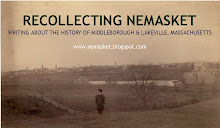.
Teachers at the Green School were monitored, and were under the watchful eye of the local School Committee which visited frequently. During 1877-78, Miss Kingman at the Green School had 8 visits from the School Committee to observe her teaching manner. Little constructive help was provided where teachers were found lacking.
While Superintendent of Schools Edward P. Fitts began teacher meetings in the fall of 1886 in order to help raise the general level of teaching in Middleborough, it was his successors, Willard T. Leonard and Asher Jacoby who took steps to establish more formalized and substantive teacher training. A training school was established in 1891 during Leonard’s tenure to fit high school graduates for teaching careers, while Jacoby wrote in 1893 that he believed one of his duties was “to improve the tone and strength of the teaching service.” Towards this end, Jacoby in 1893 instituted a series of five mandatory teacher meetings each month. “Although attendance at these meetings was required, I believe that the teachers attended cheerfully,” noted Jacoby. Separate meetings were held for each department as well, including the teachers in the “ungraded” or “mixed grade” schools such as the Green. In 1894, these meetings were held Saturday afternoons. In 1895, the suburban school teachers, including the Green, studied and discussed Arnold’s Waymarks of Teaching. These meetings proved highly successful, attracting “considerable attention in outside educational circles”, as well. In 1911, the manner in which suburban school teachers met was revised. The teachers were divided into three groups of five and attended bi-monthly meetings in the Superintendent’s office.
In October, 1893, the Middleboro Pedagogical Club was organized under Jacoby’s direction with the purpose of “the mutual improvement of its members along educational lines”. The first task undertaken was a study of educational psychology. To encourage teachers to read educational texts, volumes related to the field were kept as a library in the Superintendent’s office, and by 1895 110 volumes were included. Four years later, the number had reached 190, and the library represented an important educational resource for teachers.
Teachers were also permitted so called “visiting days” during which they were allowed to visit other schools in order to observe educational practices elsewhere. In 1897, the “Rules and Regulations” of the Middleborough School Committee set the number of these days at two per year “for the purpose of observing the modes of discipline and instruction.”
Most successful of all, however, was the Teachers’ Training Class conducted under the supervision of the Superintendent of Schools in the late nineteenth and early twentieth centuries. The purpose of the class was to provide high school graduates with a one-year training course combined with observation work in Middleborough’s central schools. The young women “were assigned after their training to vacancies, if any, in the Suburban Schools, generally caused by those former graduates of the Training Class who had been successful in such positions being transferred to the Central Schools.” While the Training Class undoubtedly provided well needed and well received instruction, it tended to underscore the suburban schools’ role as a training ground for future central school teachers, a development which ran counter to the argument that these schools, in fact, required the better-trained teachers. Nevertheless, the Training Class ensured that these women were ultimately better prepared than they otherwise would have been.
Following the end of the school year in May, 1911, the Teachers’ Training Class was abandoned. While the class had served an essential service for a number of decades, increasingly the Middleborough School Committee felt that teachers who had been trained through such institutions as the Bridgewater Normal School should be employed instead of high school graduates trained through the local course.
Helping also drive the improvement of one-room school teaching was the Middleborough School Committee’s actions throughout the period establishing higher standards for its teachers. In 1894, the School Committee adopted a policy requiring teachers in Middleborough schools to have a high school or equivalent education as well as either practical teaching experience or training in education.
NEXT PAGE: Green School Teachers, 1871-1941
PREVIOUS PAGE: Turnover & Retention
Subscribe to:
Post Comments (Atom)













+-+Copy.jpg)

+of+Smoky+Mountains+018.jpg)

No comments:
Post a Comment